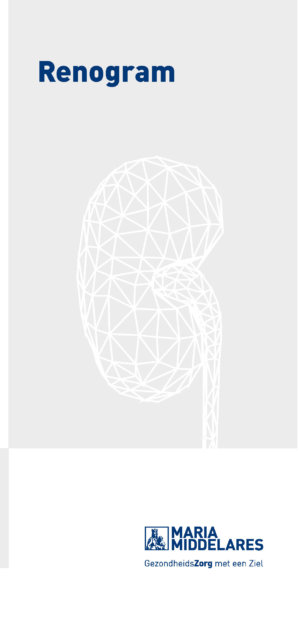Renogram
What is it?
What is it?A renogram is used to look at whether or not there are problems with the flow of urine out of the kidney. A substance is injected, which enters and exits the kidneys quickly. In addition to imaging, a renal curve is also calculated. This is the renogram. This gives an idea of the uptake, transit and exit through the kidneys.
Test procedure
Test procedurePregnancy and breastfeeding
Are you pregnant or do you think you may be pregnant? Or are you breastfeeding? Please tell the physician before the injection. The test will not be performed if you are pregnant. If you are not sure whether you are pregnant or not, the test will be postponed until you are certain.
If you are breastfeeding, make sure to discuss this with the physician before the test. You will receive additional instructions about how to avoid unnecessary radiation exposure to your child.
Preparation for the test
You do not need to be fasting for this test. It is important that you drink enough before the test in order to activate the kidneys. Go to the toilet right before the test in order to empty the bladder.
It is important to reassure and calm small children and babies before the test. Feeding your baby, for example, can help with this.
Course of the procedure
A small quantity of radioactive material will be administered intravenously in the arm. The image is taken immediately after the injection and takes 25 minutes. A diuretic is administered during the test to see if the kidney empties sufficiently. This can give the feeling of needing to urinate urgently. After the test, you will be asked to empty your bladder.
Immediately afterwards, a short image of five minutes will be taken.
If the patient is a baby, you will be asked to bring an extra diaper.
This test is sometimes combined with a DMSA scan.
After the procedure
If you are not admitted to the hospital, you can resume your normal activities after the test.
Safety and radiation
Safety and radiationThere are essentially no side effects: the injected product causes no abnormal sensations and only in very rare cases causes (very mild) allergic reactions. The injected radioactive material does constitute a dose of radiation, but it is very small (about as much as for a regular CT scan).
The quantity of radiation that you are exposed to during the test is not higher or lower depending on the number of images taken.
Results
ResultsWe prepare a report of the test. That report and the images are digitally available to the physician who requested the test.
Leaflet
LeafletOnly available in Dutch:

Renogram
DownloadCentres and specialist areas
Centres and specialist areas
Latest publication date: 16/05/2024
Supervising author: Dr Van Den Bossche Bieke



